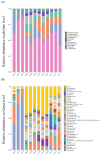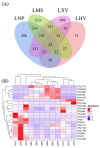Host Lifeform Shapes Phyllospheric Microbiome Assembly in Mountain Lake: Deterministic Selection and Stochastic Colonization Dynamics
- PMID: 40431132
- PMCID: PMC12113992
- DOI: 10.3390/microorganisms13050960
Host Lifeform Shapes Phyllospheric Microbiome Assembly in Mountain Lake: Deterministic Selection and Stochastic Colonization Dynamics
Abstract
The phyllosphere microbiome of aquatic macrophytes constitutes an integral component of freshwater ecosystems, serving crucial functions in global biogeochemical cycling and anthropogenic pollutant remediation. In this study, we examined the assembly mechanisms of epiphytic bacterial communities across four phylogenetically diverse macrophyte species (Scirpus validus, Hippuris vulgaris, Nymphoides peltatum, and Myriophyllum spicatum) inhabiting Ningwu Mayinghai Lake (38.87° N, 112.20° E), a vulnerable subalpine freshwater system in Shanxi Province, China. Through 16S rRNA amplicon sequencing, we demonstrate marked phyllospheric microbiome divergence, as follows: Gammaproteobacteria dominated S. validus, H. vulgaris and N. peltatum, while Alphaproteobacteria dominated in M. spicatum. The nitrate, nitrite, and pH value of water bodies and the chlorophyll, leaf nitrogen, and carbon contents of plant leaves are the main driving forces affecting the changes in the β-diversity of epiphytic bacterial communities of four plant species. The partitioning of assembly processes revealed that deterministic dominance governed S. validus and M. spicatum, where niche-based selection contributed 67.5% and 100% to community assembly, respectively. Conversely, stochastic processes explained 100% of the variability in H. vulgaris and N. peltatum microbiomes, predominantly mediated by dispersal limitation and ecological drift. This investigation advances the understanding of microbial community structural dynamics and diversity stabilization strategies in aquatic macrophyte-associated microbiomes, while establishing conceptual frameworks between plant-microbe symbiosis and the ecological homeostasis mechanisms within vulnerable subalpine freshwater ecosystems. The empirical references derived from these findings offer novel perspectives for developing conservation strategies aimed at sustaining biodiversity equilibrium in high-altitude lake habitats, particularly in the climatically sensitive regions of north-central China.
Keywords: assembly mechanisms; diversity; epiphytic bacteria; macrophyte; subalpine lakes.
Conflict of interest statement
The authors declare no conflicts of interest.
Figures








Similar articles
-
Growing season drives the compositional changes and assembly processes of epiphytic bacterial communities of two submerged macrophytes in Taihu Lake.FEMS Microbiol Ecol. 2020 Apr 1;96(4):fiaa025. doi: 10.1093/femsec/fiaa025. FEMS Microbiol Ecol. 2020. PMID: 32055830
-
The balance between deterministic and stochastic processes in structuring lake bacterioplankton community over time.Mol Ecol. 2020 Aug;29(16):3117-3130. doi: 10.1111/mec.15538. Epub 2020 Jul 24. Mol Ecol. 2020. PMID: 32628343 Free PMC article.
-
Nutrient dynamics and microbial community response in macrophyte-dominated lakes: Implications for improved restoration strategies.J Environ Manage. 2023 Jan 1;325(Pt A):116372. doi: 10.1016/j.jenvman.2022.116372. Epub 2022 Oct 14. J Environ Manage. 2023. PMID: 36252327
-
Community Structure and Function of Epiphytic Bacteria Associated With Myriophyllum spicatum in Baiyangdian Lake, China.Front Microbiol. 2021 Sep 17;12:705509. doi: 10.3389/fmicb.2021.705509. eCollection 2021. Front Microbiol. 2021. PMID: 34603230 Free PMC article.
-
Contrast diversity patterns and processes of microbial community assembly in a river-lake continuum across a catchment scale in northwestern China.Environ Microbiome. 2020 Apr 25;15(1):10. doi: 10.1186/s40793-020-00356-9. Environ Microbiome. 2020. PMID: 33902721 Free PMC article.
References
-
- Bornerre G., Puijalon S. Response of aquatic plants to abiotic factors: A review. Aquat. Sci. 2011;73:1–14. doi: 10.1007/s00027-010-0162-7. - DOI
-
- Hilt S., Gross E.M., Hupfer M., Morscheid H., Mählmann J., Melzer A., Poltz J., Sandrock S., Scharf E.M., Schneider S., et al. Restoration of submerged vegetation in shallow eutrophic lakes—A guideline and state of the art in Germany. Limnologica. 2020;36:155–171. doi: 10.1016/j.limno.2006.06.001. - DOI
Grants and funding
LinkOut - more resources
Full Text Sources

